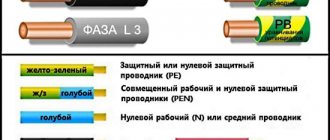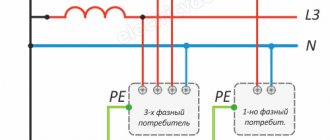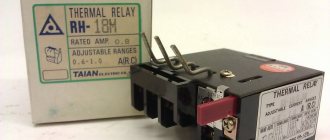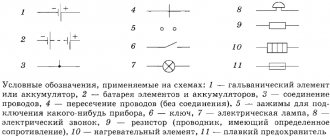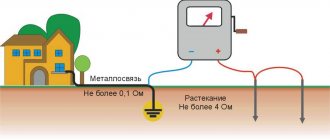Letter marking of wires
If the voltage of electrical devices does not reach 1000V, then the marking of wires is regulated by certain GOST R 50462-2009.
Phase wire and its designation
As you know, the electrical network uses alternating current, and the so-called “phase” or phase cable is energized. It is marked with the English symbol “L”, from the word “Line”, meaning the word “line”.
This letter also designates the terminals to which this wire is connected. If there is not one phase, but several of them, then the serial number L1, L2, L3 or the Latin letters A, B, C are added.
Phase wires must always be reliably insulated, since in an exposed state they can cause serious danger to human health.
“Neutral”, “zero” or what is “N”?
In English there is a word “neutral”, which translates as “neutral”. That is why the letter N is used to designate a neutral cable. In our country, the neutral wire is most often called zero from the word “NULL”.
In addition, it is worth taking into account that the neutral is the wire through which voltage is removed from the electrical appliance, and accordingly, it is taken as a minus sign.
Grounding
What is phase and zero is now clear. But there is also such a sign - RE. This is the so-called “ground” or grounding wire. The abbreviation, again translated from English, is Protective Earthing. Ground terminals are also identified by these symbols.
l and n in electrical engineering – what should you know?
To safely connect electrical appliances, you should always check the markings of cables and terminals with symbols (l, n and PE), as well as the color of the wire insulation. As testing equipment, you can use a tester - a special indicator screwdriver.
If this device is not at hand and you are not confident in your own competence, we advise you to contact a professional electrician.
Color codes for phase L, neutral N and ground
For ease of installation, any electrical cable is made with multi-colored insulation on the cores. When installing standard electrical wiring, three-core cables are usually used (phase, neutral, ground). Phase (“L”, “Line”) The main wire in the cable is always the phase. The word "phase" itself means "live wire", "active wire" and "line". Most often it comes in strictly defined colors. In the distribution panel, the phase wire, before going to the consumer, is connected through a residual current device (RCD, fuse), and phase switching occurs in it. Attention! There are no jokes with the bare phase, so in order not to confuse the phase with anything else, remember: the phase contacts are always marked with the Latin symbol “L”, and the phase wire can be red, brown, white or black ! If you are not sure about this or the wiring is arranged differently, then purchase a screwdriver with a simple phase indicator. By touching its tip to the bare conductor, you can always find out whether it is a phase or not by the characteristic glow of the indicator. It’s better to immediately contact a qualified specialist. Zero (“N”, “Neutre”, “Neutral”, “Neutral” “Zero”) The second important wire is zero, popularly known as “wire without current”, “passive wire” and “neutral”. It only comes in blue . In apartment distribution panels it must be connected to the zero bus, it is marked with the symbol “N”. To the socket, the zero wire is connected to the contacts, also marked with the sign “N”. Grounding (“G”, “T”, “Terre” “Ground”, “gnd” and “Earth”) The insulation of the ground wire is only yellow with a green stripe. In the distribution panel it is connected to the grounding bus, to the door and body of the panel. In sockets, grounding is connected to contacts marked with the Latin symbol “G” or with a sign in the form of an inverted and briefly underlined letter “T”. Typically, grounding contacts are visible and can protrude from sockets, becoming accessible to children, which sometimes causes shock to many parents; however, these contacts are not dangerous, although sticking your fingers there is still not recommended.
Attention! When working with live electrical networks, there is always a high probability of electric shock or fire. Even if an RCD is installed, it is strongly recommended to follow all safety precautions! It is known that the special design of such a switch checks the synchronism of the phase and zero operation, and if the RCD detects a phase current leak without returning some of its percent to zero, it will immediately break the contact, which will save a person’s life; however, if you touch not only the phase, but also zero, then the RCD will not save you. Touching both wires is deadly!!!
Zero designation - N
To mark the neutral or zero working core of the network, use the letter “N”. This is an abbreviation of the term neutral (translated as neutral). This is what is commonly called the neutral conductor all over the world. In our country, the word “Zero” is mostly used.
Most likely, the word NULL is taken as a basis here. The letter “N” in the diagram indicates contacts or terminals intended for switching the neutral core. A similar designation is accepted for both single-phase and three-phase circuits. Blue or white-blue (white-blue) insulation is used as a color designation for the neutral wire.
Phase, neutral and ground color
In addition to letter markings, conductors vary in color. This is a requirement of the PUE standards and GOST R 50462-2009. Color coding is necessary for safe and correct electrical installation, eliminating errors and malfunctions.
Phase color
We discussed above what a phase is in electricity. This is the main active conductor that is always energized. Therefore, he is the most dangerous. The color of the phase can be red, black, brown or white. Pink, purple, orange, and turquoise shades can also be found.
Important - the phase core must be bright and eye-catching!
Sometimes the following question arises: there is a red wire - is it a plus or a minus? Let's figure it out.
The “plus” symbol usually denotes a phase, that is, a wire through which voltage is supplied to an electrical appliance.
Neutral color
To mark the neutral wires, blue or its slight shades is used. Other colors for neutrals are prohibited.
Ground color
This wire is only present in three-core cables. It has a protective function against electric shock if the insulation is damaged or the device is faulty. According to the European standard IEC 60446:2007, the ground wire must be green-yellow. For example, it can be yellow with a greenish stripe or vice versa. All other colors are prohibited.
In two-core cables, the ground and neutral conductors are combined. In this case, the insulation of such a wire will be blue with yellow-green ends.


